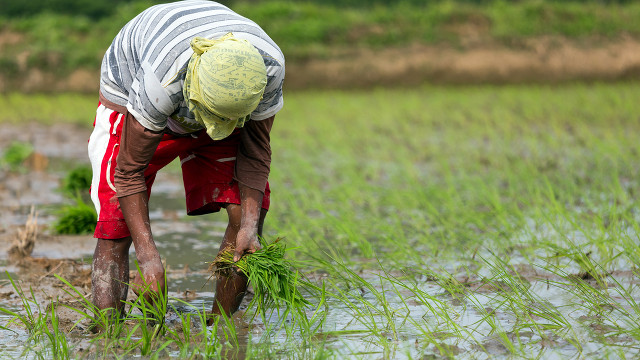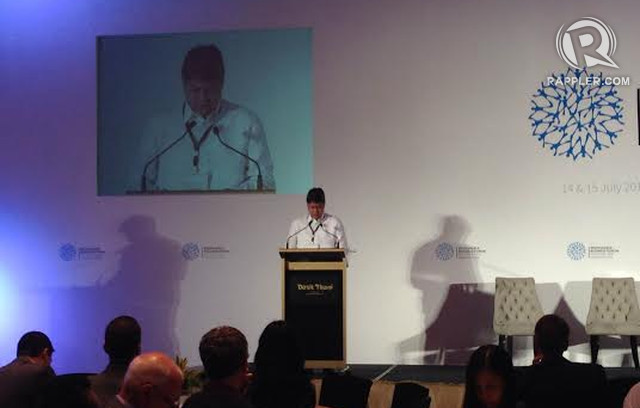SUMMARY
This is AI generated summarization, which may have errors. For context, always refer to the full article.

MANILA, Philippines – With Filipino farmers and fishermen among the poorest in the country, and climate change and a growing population threatening food security, government needs to put farmers and fishermen first. (READ: PH agriculture: Why is it important?)
These were the words of Secretary Francis Pangilinan, Presidential Assistant on Food Security and Agricultural Modernization, during an international forum on Monday, July 14.
In front of scientists, business leaders and civil society organizations, Pangilinan admitted that despite the country’s fast-growing economy, the agriculture sector and the farmers and fishermen who form its backbone, continue to languish. (READ: PH oceans in crisis: The sad state of small fisherfolk)
“Economic growth is not felt by 20 million Filipinos. If we are, in this country, to reach developed nation status in the next 10 to 15 years, we must address income and growth in the agricultural sector. We must put farmers, fisherfolk and agricultural communities first,” he said.
Poor farmers, fisherfolk and people indirectly employed by agriculture make up almost 60% of the country’s labor force.
The average Filipino farmer, he said, is 57 years old with an educational attainment of grade 4. He makes roughly P23,000 ($529)* a year and owns just 1.5 hectares of land. (READ: Many poor in PH? NSCB cites dismal agri sector)
Meanwhile, the average Chinese farmer earns around 6,000 yuan a year ($967). The average Thai farmer earns 44,000 Thai Baht ($1,370).
One way to save Philippine agriculture, Pangilinan said, is to increase the income of farmers and fisherfolk. That way, they will continue farming and providing much-needed food for the country’s growing population and contribute more to the economy.
Farmers with good income can also make farming “sexy” to encourage young Filipinos to take more interest in agriculture and thus ensure the strength of the agricultural sector for many years to come.
Solutions
Pangilinan said he is looking at various solutions to improve agriculture and the lives of farmers and fisherfolk.
First, the government needs to “take the lead in enabling modernization, innovation, and growth in agriculture by allocating greater resources for agriculture and fisheries.”
This means more funds for infrastructure such as farm-to-market roads, irrigation and post-harvest facilities. Government should also fund research on effective agricultural methods, product development, packaging development, and improving access of farmers and fisherfolk to markets.
Pangilinan also pointed at improved access to credit as an area where government can step in.
While the strategy is to get banks to lend more money to farmers, he emphasized it’s also a matter of making farmers more viable and bankable.
Banks would be more willing to lend if they had guarantees that farmers can pay back the loan.
“There should be crop insurance. You create now a mechanism of support around the farmer so he becomes bankable,” he said.
Another option is to link more farmers with micro-finance organizations who loans to small entrepreneurs or to create tie-ups between banks and micro-finance organizations.
Private sector can save PH agriculture
While government, and particularly his office, has the mandate to boost the agricultural sector, Pangilinan stressed that the private sector is likely to make the biggest impact.
“The government contributes 15% of GDP (Gross Domestic Product). Around 85% comes from the private sector. It’s the private sector that has the deepest pockets. And it’s the one with the deepest pockets that can ensure strategic and sustainable long-term efforts.”

Creative entrepreneurs, with their business savvy, knowledge of the market and resources can link with farmers who know how to make the land productive. (READ: The business of agribusiness)
This would give rise to the social enterprise model exemplified in such success stories as Gawad Kalinga, Rags2Riches and Hapinoy.
If done right, this model could “turn farmers from mere laborers to co-owners of healthy agri-businesses based on the equitable distribution of resources,” hoped Pangilinan.
Big companies like Starbucks, Jollibee and Mars Chocolate source many of their ingredients from Philippine farming communities. Smaller entrepreneurs are working with farmers to develop products like organic rice, high-end cheese and artisanal chocolate.
But he admitted that government should set the stage for such partnerships by offering tax incentives to social enterprises, streamlining the bureaucracy and stamping out red tape and corruption.
Agriculture is ripe for investment given the expected surge in demand as the country’s – and the world’s – population grows.
Over the next 35 years, the Philippine population will rise from 100 million to 140 million, said Worldwide Fund for Nature (WWF) Philippines chief executive officer Lory Tan. Global population is rising from 7 billion to 9 billion in 2050, he added.
With two billion more people in the world by 2050, humanity needs to produce twice as much food, said Jason Clay, WWF United States Senior Vice President for Markets and Food.
More efficient agriculture that uses less resources to make more food is where farmer empowerment and multi-stakeholder collaborations can come in.
The way to improve Philippine agriculture and get it ready for the ASEAN Economic Community in 2015 is to think out of the box instead of treating the sector as an “outdated side project,” said Pangilinan.
He concluded, “We must look at the farmers first. After all, more than the doctor, more than the lawyer, we need the farmer. Because we need a doctor or lawyer only a few times in our life, but we need a farmer 3 times a day.” – Rappler.com
Filipino farmer image via Shutterstock
Add a comment
How does this make you feel?





There are no comments yet. Add your comment to start the conversation.